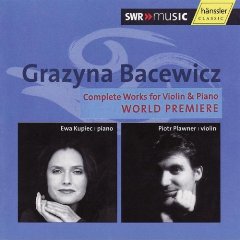Grazyna Bacewicz - Sonatas for Violin & Piano (2006)
Grażyna Bacewicz - Sonatas for Violin & Piano (2006)

Disc 1 Partita 1 I. Preludium: Grave 3:41 2 II. Toccata: Vivace 3:15 3 III. Intermezzo 2:26 4 IV. Rondo: Presto 3:08 Violin Sonata No.5 5 I. Moderato 5:17 6 II. Nokturn: Andante dolcissimo 2:39 7 III. Finale: Allegro inquietamente 5:00 8 Humoreske 2:41 9 Kolysanka (Lullaby) 2:22 Violin Sonata No. 4 10 I. Moderato 5:33 11 II. Andante ma non troppo 4:29 12 III. Scherzo: Molto vivace 3:26 13 IV. Finale: Con passione 5:39 14 Witraz 2:58 Violin Sonata No. 1, "da camera" 15 I. Largo 2:26 16 II. Allegro 2:10 17 III. Tempo di minuetto 2:12 18 IV. Andante sostenuto 2:35 19 V. Gigue: Molto allegro 1:52 20 Melodia 2:58 Disc 2 Violin Sonata No. 3 1 I. Allegro moderato 4:43 2 II. Adagio 4:09 3 III. Scherzo: Vivo 3:20 4 IV. Finale: Andante 5:51 Violin Sonata No. 2 5 I. Allegro 3:30 6 II. Andante 4:03 7 III. Scherzo: Vivace 3:19 8 IV. Finale: Allegro molto 2:53 Two Oberki 9 No. 1: Presto 1:53 10 No. 2: - 2:33 Concertino 11 I. Allegro moderato 1:11 12 II. Romance: Andante 2:01 13 III. Finale: Vivace 1:28 14 Caprice 2:04 15 Theme with Variations 7:17 3 Dances 16 I. Mazovian Dance: Andante 2:57 17 II. Polish Dance: Sywo 2:10 18 III. Slavonic Dance: Andante 3:10 Ewa Kupiec - piano Piotr Plawner - violin
Grazyna Bacewicz (1909-1969) was the first Polish woman to become a famous composer. Educated in Paris under the legendary Nadia Boulanger, she became a master violinist and most of her compositions feature that instrument. Seriously injured in a car accident in 1954, she then gave up performing and teaching to concentrate on composing. Pianist Ewa Kupiec is the preeminent interpreter and advocate of the music of Grazyna Bacewicz. Her previous release of the complete published piano music received global acclaim. Pianist Kupiec is joined by virtuoso violinist Piotr Plawner in spirited and authentic interpretations of this neglected master's music for violin and piano. The music of Bacewicz is extremely accessible, yet modern. While she explored many different styles, her music is based in the traditions of Polish folk music. New interest in the music of Bacewicz makes this an extremely attractive addition to any collection. ---Editorial Reviews, amazon.com
In the business of summing up the resultant hierarchy of what matters most in twentieth century musical literature, the violin music of Grazyna Bacewicz might gain consideration only as representing rather exotic repertoire, and this shouldn't be so. Bacewicz was an expert violin soloist who was a well-known commodity in postwar Europe; she won the Olympic music competition in London in 1949, the UNESCO prize in 1960, and captured the Belgian Reine-Elisabeth prize three times. Bacewicz's compositional output for violin and piano is of the first tier and is exceptionally notable in that in stylistic terms it remains recognizably modern, but stands outside trends current in Bacewicz's time. The word neo-Classical is sometimes applied to describe it, and she did study with Nadia Boulanger, but this superficial evaluation suits Bacewicz's music rather uncomfortably; one could say it's vaguely like Bartók, but draws from Polish folk material and even that qualification only weakly describes its effect. It's energetic and a little showy in fast movements and expressive, yet a little cool, in slower ones, fits the violin like a glove, and always leaves a distinct impression. It is very important violin literature, and there's never been so much of it offered in a single-CD package as in this two-disc set from Hänssler Classic, Grazyna Bacewicz: Sonatas for Violin and Piano.
Piotr Plawner is a young violinist who is, as Bacewicz was, a native of Lodz. Plawner adapts easily to the varied technical and expressive hurdles encountered in Bacewicz's violin music; he is hushed and mysterious in the early piece Witraz (Stained Glass Windows, 1932), dazzlingly propulsive in the Finale of the Sonata No. 2, and obviously enjoys such challenges as the leaps, pizzicato, and glissandi employed in Bacewicz's folk-like Two Oberki (1951). Plawner lavishes as much care on Bacewicz's lighter short pieces such as the Concertino (1945) -- which consists of three movements that take less than five minutes to play -- to weightier music as the five sonatas, all of which are included here. Occasional short pieces scattered throughout the program add depth to Bacewicz's violin output but do not betray any sense of forward development in her style, the essentials being the same whether the music comes from 1952 or 1932.
The breaks between pieces are rather long and the recording is rather dry and a little on the quiet side. Pianist Ewa Kupiec, who does turn in a strong performance here (though one wonders how Plawner's regular piano partner, Krystian Zimerman, might have fared in this material) is credited everywhere on this above Plawner by Hänssler Classic. But make no mistake; he's the star of the show here. Everyone who enjoys twentieth century violin music owes it to themselves to discover Bacewicz' music, and this is a terrific option for it and the most generous in terms of programming. Nevertheless, it doesn't entirely supplant the excellent Chandos recording of some of this music by Joanna Kurkowicz and Gloria Chien; Kurkowicz is just as facile and exciting in the music, and the recording quality of the Chandos is better, which makes a difference. ---Uncle Dave Lewis, AllMusic Review
download (mp3 @320 kbs):
Zmieniony (Sobota, 01 Wrzesień 2018 20:00)








